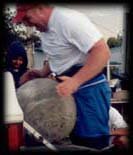Program #1: Working Out To Build Mass
If your goal is to put on as much mass as your genetics will allow, consider the following. First off, in order to gain muscle you may also need to gain some fat. This may sound discouraging but there are ways to keep the fat weight to a minimum. Get yourself in tune to eating about 500 calories more each day, and be sure to spread meals out to 5-or-6 daily. Be careful though, most athletes try to get these extra calories through fat sources.
It's best to get these calories predominantly from lean sources of protein (e.g. chicken, whey protein, etc.), with some complex carbohydrate and essential fats thrown in the mix. Make sure the extra calories are coming from the recommended percentages of fats, carbohydrates, and proteins. An increase in body weight of roughly 0.5 to 1.0 pounds. per week is a reasonable goal. Anymore weight gain than that and you're risking the dreaded spare tire.
 For maximal gains in muscle mass, keep your reps between 5-and-12 and switch reps schemes every 3-to-4 weeks. This will keep the muscle guessing on what you're doing to it and keep you from overtraining. Now, here's the part that is guaranteed to get some of you hopping mad. DON'T TRAIN HEAVY ALL THE TIME. In other words, if you're training with reps of 10, don't train till failure every time you lift. And I don't care if you're natural or not. Your body will increase faster if you switch training intensity between light, medium, or heavy.
For maximal gains in muscle mass, keep your reps between 5-and-12 and switch reps schemes every 3-to-4 weeks. This will keep the muscle guessing on what you're doing to it and keep you from overtraining. Now, here's the part that is guaranteed to get some of you hopping mad. DON'T TRAIN HEAVY ALL THE TIME. In other words, if you're training with reps of 10, don't train till failure every time you lift. And I don't care if you're natural or not. Your body will increase faster if you switch training intensity between light, medium, or heavy.
Trust me, it works. You'll feel better, stay hungry for the gym, and you'll keep injuries to a minimum. If your main goal is mass, mass, mass, then I would keep aerobic training to a minimum. In fact, you may just want to keep aerobic training out of your training completely. I wouldn't do anymore than 20 minutes, 2-to-3 times per week.
Here's an example of what a training program might look like. Now remember, this is not the magic program that you stick with for the rest of your life. In fact, I wouldn't stay on it any longer than 4 weeks. It's just an example. You need to switch things up every couple of weeks.
NOTE: Click the exercise name to view the exercise and learn the correct form!
Monday
| Bench press | 1x12, 10, 10 |
| Incline press | 1x12, 10, 10 |
| Military press | 1x12, 10, 10 |
| Side-raise | 3x12 |
| Tricep ext | 3x12 |
| Kickback | 3x12 |
 Click Here For A Printable Log Of Monday!
Click Here For A Printable Log Of Monday!
Tuesday
| Pull down | 1x12, 10, 10 |
| Seated Row | 1x12, 10, 10 |
| Bent-over-raise | 1x12, 10, 10 |
| Shrugs | 3x12 |
| Barbell Curl | 3x12 |
| DB Curl | 3x12 |
 Click Here For A Printable Log Of Tuesday!
Click Here For A Printable Log Of Tuesday!
Wednesday
-
Take a day off. Eat plenty and sleep.
Thursday
| Squat | 1x12, 10, 10 |
| Lunges | 3x12 |
| Stiff-Legged Dead lift | 3x12 |
| Leg Curl | 3x12 |
| Calf-raise | 5x12 |
 Click Here For A Printable Log Of Thursday!
Click Here For A Printable Log Of Thursday!
Friday
-
Start rotation over. Workout Saturday if you feel like it. If not, wait till Monday for another workout.
Program #2: Gaining Muscle & Losing Fat
If you are like most people out there, whether you're a gym rat ora coach potato, then gaining muscle and losing fat is what you dream about. Of course, gaining muscle and losing fat is as difficult as getting a politician to tell the truth. You need to know dietary habits and needs. If you're a nerd who needs numbers, than keeping track of your calories, proteins, carbs and fats may be warranted.
In other words, are you getting the correct percentages from protein, carbohydrate and fat? How many calories are you taking in? Do you need to decrease calories, stay the same, or increase? This all sounds like a whole lot to figure out, but it's not too bad. Keep track of your food for 2 days during the week and 1 weekend day. Then get yourself a chart, computer program, book, whatever ... that gives you the low down on what's in each of the foods you eat. You could probably find these things at your local bookstore. Another suggestion would be to look up a sports nutritionist in your area that could help you.
"Nutrition is a big part, but what about the workout," you ask? Well, that's next. Your workouts should include resistance training along with aerobic work. Now, for the people out there that are fearful of getting "too big," don't worry. You're not going to hit the gym today, roll out of bed tomorrow, look into the mirror, and realize you look like Dorian, Arnold or Sergio. It's not going to happen. The fact is, the more resistance-training you do, the higher your metabolic rate. That means you'll burn more calories whether working out or watching television.
You're resistance training should consist of reps between 6-and-12. Include light, medium and heavy intensity days. Change your rep schemes around each week to keep you fresh and to keep you on track for making gains. Keep your lifting routines at 30-to-45 minutes max. Also, keep aerobic work to 20-to-30 minutes, 3-to-4 times per week. Keep your heart rate in the 60 to 90% of heart rate max for best results. Be sure to lift first and do aerobic work second. The lifting gets glycogen levels to decrease so that you may burn more fat when doing aerobic work.
The following is a workout program for you to look at. Now, this is just here to give you an idea of what I'm talking about. It's not the answer. In other words, you'll still want to switch things up every couple of weeks or so.
Monday
| Bench press | 3x12 |
| Incline fly | 3x12 |
| Military press | 3x12 |
| DB French press | 3x12 |
| Aerobic Work | 20 to 30 minutes. Heart rate at 60 to 90%. |
 Click Here For A Printable Log Of Monday!
Click Here For A Printable Log Of Monday!
Wednesday
| Squat | 3x12 |
| Lunges | 3x12 |
| Leg Curl | 3x12 |
| Pull down | 3x12 |
| Seated Row | 3x12 |
| Barbell Curl | 3x12 |
| Aerobic Work | 20 to 30 Minutes. |
 Click Here For A Printable Log Of Wednesday!
Click Here For A Printable Log Of Wednesday!
Friday
| Squat | 3x12 |
| Bench Press | 3x12 |
| Lat pull down | 3x12 |
| Barbell Curl | 3x12 |
| DB French press | 5x12 |
| Aerobic Work | 20 to 30 minutes. Heart rate at 60 to 90%. |
 Click Here For A Printable Log Of Friday!
Click Here For A Printable Log Of Friday!
Program #3: Weight Loss Program
If weight loss is what you're looking for then here's what you need. The best combination for weight loss is calorie restriction, resistance training, and aerobic work. Let's start with calorie restriction. Over the years I have had personal training clients as well as athletes come to me wondering why they are not losing weight. They tell me they eat right, exercise right, say their prayers, eat their vitamins, etc., and they just can't seem to lose weight. Well, most of the time, once I really get to know them, I find that nutrition is the culprit. You need to know what you're eating. Most of the people I'm talking about all thought they did.
How do you change this? Well, it may sound tough, but it's not that bad. You need to keep track of what you eat for 2 days over the week, and 1 day over the weekend. Next, go to you're local book store. You can find charts, books and computer programs that will help you analyze the foods you ate. Another suggestion would be to take your dietary recall to a nutritionist or exercise physiologist at your local college and let them find it for you.
These recalls will tell you how many calories you're getting plus where they are coming from. For example, are they coming from protein, carbohydrate or fat. It will help you see where you stand nutritionally.
Next, you need to get on a good strength program. When a person is losing weight, the weight comes from fat, as well as muscle. That's kind of an unfortunate thing because muscle is an important thing when keeping metabolism high. There is enough research out there to safely say that when going through a phase of high intensity aerobic work and calorie restriction, strength training decreases muscle wasting. So, in short, strength-train. It's important. I wouldn't strength-train for anymore that 20-to-30 minutes. You can get what you need in a short period of time.
After the strength training, it's time to get on the bike, treadmill, stepper, track, whatever. Keep your workouts to 30 minutes and up in order to burn the calories. Train between 3-to-5 times per week. Keep your heart rate at 60 to 90% of heart rate max.
Don't look at losing weight as some mysterious monster that you can't get the reins on. Look at it as nothing more than stored energy. That's what fat is … stored energy. If you had a tank full of energy and it kept filling up higher and higher, what would you do to keep your tank from growing too large from the excess energy? Well, burn some of the energy off. That's what you need to do to lose weight. Keep the "energy in" lower than the "energy out" and abracadabra, you're losing weight.
Note: You need to change your routine every 2-3 weeks in order to get the best results.
Monday
| Leg Press | 2x12 |
| Chest Press | 2x12 |
| Lat pull down | 2x12 |
| Shoulder Press | 2x12 |
| DB Curl | 2x12 |
| Tricep kickback | 2x12 |
| Aerobic Work | 30 or more minutes. |
 Click Here For A Printable Log Of Monday!
Click Here For A Printable Log Of Monday!
Tuesday
-
Aerobic work 30 or more minutes of aerobic exercise.
Wednesday
-
Same as Monday.
Thursday
-
Same as Monday, or take a day of rest.
Friday
-
Same as Monday.
About The Author
Mike Sanders, MA, CSCS, is the assistant strength and conditioning coach at the University of Nebraska-Kearney, and is a Certified Club Coach with the United States Weightlifting Federation. He has written articles that have appeared in the Strength & Conditioning Journal, Current Therapeutic Research and Muscular Development. He is currently the strength and conditioning coach for the wrestling, softball, tennis and cross-country teams.
